
Billions of individuals manage a nail-gnawing propensity sooner or later in their lives.
Many will take incredible measures to attempt to stop,
utilizing methodologies like scouring bean stew peppers on their fingernail skin,
wearing gloves the entire day, dunking their hands in salt,
also, imagining microbes slithering on their fingers.
And keeping in mind that not we all are nail-biters,
the vast majority of us truly do have a propensity we might want to kick.
So what's the most ideal way to break one?
Researchers characterize propensities as ways of behaving that are performed consistently,
furthermore, prompted subliminally because of specific conditions,
whether it be an area, season of day, or even a close to home state.
They can incorporate straightforward activities like picking your hair when pushed,
yet additionally more perplexing practices imbued in everyday schedules,
like keeping awake until late or preparing your espresso toward the beginning of the day.
In the event that you accomplish something every now and again, absent a lot of consultation,
then it's possible a propensity.
They structure on the grounds that sooner or later your mind discovers that the way of behaving is valuable.
Suppose subsequent to opening an upsetting email, you nibble your nails.
This is fulfilling, as concentrating is sufficient,
controling your email powered uneasiness.
Inside your mind, positive encounters can set off the arrival of dopamine,
a synapse that intervenes sensations of delight.
Dopamine is likewise a driver of brain adaptability,
meaning it can change how your neurons wire and fire.
Your cerebrum fabricates associations that interface the award with the way of behaving,
driving you to rehash it.
It additionally begins connecting the way of behaving with different prompts, similar to your current circumstance.
Ultimately, everything necessary is the setting of sitting at your work area
to subliminally trigger a nail-gnawing propensity —
no upsetting email or positive feeling required.
When laid out, these sign conduct reward circles work quick,
outperforming the dynamic interaction.
You might end up participating in a propensity
before you get the opportunity to notice and stop.
Be that as it may, this can be something to be thankful for on the grounds that not all propensities are awful.
They're put away recollections of what's worked before,
which permit you to make a quick move in the present.
One review assessed that overall,
individuals spend over 40% of their days performing consistently rehashed ways of behaving
while their brains are busy with different considerations.
An apparently mechanized morning schedule, for instance,
saves you both time and valuable mental energy.
In any case, many individuals have propensities that never again serve them.
However research shows that expectations alone frequently fizzle
to prompt long haul conduct change.
This isn't to say you can't bring an end to a propensity.
Rather, by grasping the premise of propensities,
you can make better designs for evolving them.
For instance, we realize propensities are frequently prompted by conditions and schedules.
Lying in bed might make you unendingly look at your telephone,
or on the other hand staring at the television on the love seat might lead you to snatch a sweet bite.
One of the best ways of overseeing conduct
is to distinguish these areas or seasons of day.
Then, at that point, attempt to adjust them by changing your daily schedule
or on the other hand making hindrances that make it more hard to play out the propensity
there.
Moving, exchanging position, or in any event, beginning another timetable,
are especially incredible times to get out from under a propensity or construct another one.
One 2005 review followed college understudies' working out,
perusing, and television watching propensities when they moved schools.
At the point when understudies were presently not around old conditions and schedules,
their propensities, even areas of strength for the, altogether different.
For ways of behaving like nail-gnawing or hair-pulling,
a pursue called routine inversion preparing can be useful.
Created by analysts during the 1970s,
the point is to work on a propensity by supplanting it with another
that is less adverse.
The preparation expects you to examine and comprehend your propensity signals,
so you can successfully intercede at the perfect opportunities.
For instance, in the event that you will generally nibble your nails at work,
prudently keep a squirm toy at your work area.
Then, in the event that a distressing email comes in,
utilize the toy when you want to chomp your nails.
Getting out from under a propensity takes time,
so make sure to give yourself beauty and have persistence through the cycle.
And keeping in mind that many spotlight on their persistent vices,
it's likewise worth praising the great ones
that assist us with moving quickly and effectively through our day to day schedules.
About the Creator
Enjoyed the story? Support the Creator.
Subscribe for free to receive all their stories in your feed. You could also pledge your support or give them a one-off tip, letting them know you appreciate their work.





Comments
There are no comments for this story
Be the first to respond and start the conversation.